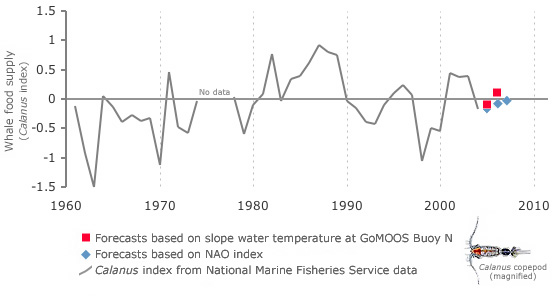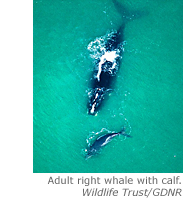Environmental Prediction in the Gulf of Maine
Forecast of North Atlantic right whale births
Forecasting whale food supply (Calanus plankton)

A mathematical model is used to predict the abundance of the right whale's primary food, Calanus copepods. The neural network model calculates predictions based on the slope-water temperature measured six months earlier and Calanus abundance in the preceding two months. The graph above shows the latest predictions along with past Calanus data from the U.S. National Marine Fisheries Survey plankton sampling program. The forecast based on direct temperature measurements at GoMOOS Buoy N is considered more accurate than the forecasts based on temperature predictions arising from the NAO index. The forecast of food supply can be plugged into a subsequent model (see step 4. Whale calves) to forecast the right whale's birth rate.
Sign up to get new forecasts by email.

Ocean currents affect food supply for right whales in the Gulf of Maine
Right whales eat tiny, free-swimming crustaceans called Calanus copepods, which are the size of rice grains and resemble shrimp. The amount of whale food in the Gulf of Maine can rise or fall dramatically from one year to the next. Warm Slope Water, which enters the Gulf of Maine after the NAO index turns positive, is associated with abundant Calanus. Labrador (cold) Slope Water, which enters the Gulf after the NAO index turns negative, is associated with scarce food. There is a lag of approximately one year before changes in slope water are reflected in the abundance of Calanus.


